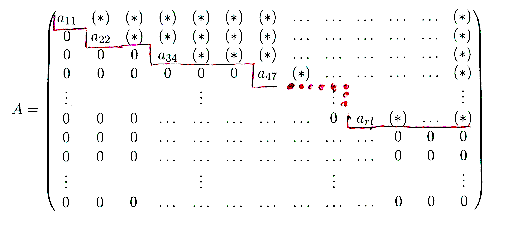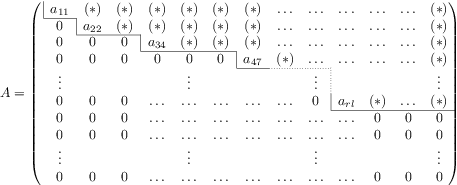|
Ich würde gerne in einer Matrix in Zeilenstufenform (also nach der Anwendung des Gauß-Algorithmus) die Stufen einzeichnen. \documentclass[a4paper]{scrartcl} \usepackage[english]{babel} \usepackage[utf8]{inputenc} \usepackage{amsmath,amssymb,amstext,amsthm} \begin{document} \setcounter{MaxMatrixCols}{15} \[A=\begin{pmatrix} a_{11} & (*) & (*) & (*) & (*) & (*) & (*) & \ldots & \ldots & \ldots & \ldots & \ldots & (*) \\ 0 & a_{22} & (*) & (*) & (*) & (*) & (*) & \ldots & \ldots & \ldots & \ldots & \ldots & (*) \\ 0 & 0 & 0 & a_{34} & (*) & (*) & (*) & \ldots & \ldots & \ldots & \ldots & \ldots & (*)\\ 0 & 0 & 0 & 0 & 0 & 0 & a_{47} & (*) & \ldots & \ldots & \ldots & \ldots & (*) \\ \vdots & & & & \vdots & & & & \vdots & & & & \vdots \\ 0 & 0 & 0 & \ldots & \ldots & \ldots & \ldots & \ldots & 0 & a_{rl} & (*) & \ldots & (*) \\ 0 & 0 & 0 & \ldots & \ldots & \ldots & \ldots & \ldots & \ldots & \ldots & 0 & 0 & 0 \\ 0 & 0 & 0 & \ldots & \ldots & \ldots & \ldots & \ldots & \ldots & \ldots & 0 & 0 & 0 \\ \vdots & & & & \vdots & & & & \vdots & & & & \vdots \\ 0 & 0 & 0 & \ldots & \ldots & \ldots & \ldots & \ldots & \ldots & \ldots & 0 & 0 & 0\end{pmatrix}\] \end{document} Das Endergebnis habe ich per Hand eingezeichnet und als Bild hochgeladen:
Ich habe bisher die Treppenstufen per |
|
Um die vertikalen Linien neben einer bestimmten Zelle einzufügen verwendet man am besten \multicolumn{1}{|c}{...} Eigentlich ist \cline{i-j} wobei Im Beispiel verwende ich \begin{pmatrix}...\end{pmatrix} ist ungefähr äquivalent zu \left(\hskip-\arraycolsep \begin{array}{*{\theMaxMatrixCols}c}...\end{array} \hskip-\arraycolsep\right) Damit erhält man folgendes Beispiel: \documentclass{article} \usepackage{amsmath} \usepackage{arydshln} \setlength\dashlinedash{0.4pt} \setlength\dashlinegap{1.4pt} \setlength\arrayrulewidth{0.4pt} \begin{document} \begin{equation*} A = \left(\mkern3mu % \hskip-\arraycolsep \begin{array}{*{13}c} \multicolumn{1}{|c}{a_{11}} & (*) & (*) & (*) & (*) & (*) & (*) & \ldots & \ldots & \ldots & \ldots & \ldots & (*) \\ \cline{1-1} 0 & \multicolumn{1}{|c}{a_{22}} & (*) & (*) & (*) & (*) & (*) & \ldots & \ldots & \ldots & \ldots & \ldots & (*) \\ \cline{2-3} 0 & 0 & 0 & \multicolumn{1}{|c}{a_{34}} & (*) & (*) & (*) & \ldots & \ldots & \ldots & \ldots & \ldots & (*)\\ \cline{4-6} 0 & 0 & 0 & 0 & 0 & 0 & \multicolumn{1}{|c}{a_{47}} & (*) & \ldots & \ldots & \ldots & \ldots & (*) \\ \cline{7-7}\cdashline{8-9} \vdots & & & & \vdots & & & & \vdots & \multicolumn{1}{:c}{} & & & \vdots \\ 0 & 0 & 0 & \ldots & \ldots & \ldots & \ldots & \ldots & 0 & \multicolumn{1}{|c}{a_{rl}} & (*) & \ldots & (*) \\ \cline{10-13} 0 & 0 & 0 & \ldots & \ldots & \ldots & \ldots & \ldots & \ldots & \ldots & 0 & 0 & 0 \\ 0 & 0 & 0 & \ldots & \ldots & \ldots & \ldots & \ldots & \ldots & \ldots & 0 & 0 & 0 \\ \vdots & & & & \vdots & & & & \vdots & & & & \vdots \\ 0 & 0 & 0 & \ldots & \ldots & \ldots & \ldots & \ldots & \ldots & \ldots & 0 & 0 & 0 \end{array} \hskip-\arraycolsep\right) \end{equation*} \end{document} Das sieht sehr gut aus, danke! Ist es noch möglich, einen Teil der Linien zu stricheln?
(09 Mai '16, 10:57)
Hirshy
cdashline, klingt logisch, vielen Dank!
(09 Mai '16, 11:08)
Hirshy
|



@Hirshy: Bitte Bilder nicht als Links auf ganzseitige Abbildungen mit viel weißem Rand darum, sondern möglichst kompakt und direkt eingebettet. Bei einem Klick auf das Bild-Symbol in der Toolbar kann dazu die Abbildung direkt auf TeXwelt hochladen. Vorher ggf. mit einem Grafikprogramm zuschneiden. Mit
standalonekann man sehr einfach Bilder mit minimalem Rand erzeugen. Screenshot-Qualität reicht hier normalerweise ebenfalls aus.@saputello, alles klar, werde ich beim nächsten Mal machen!